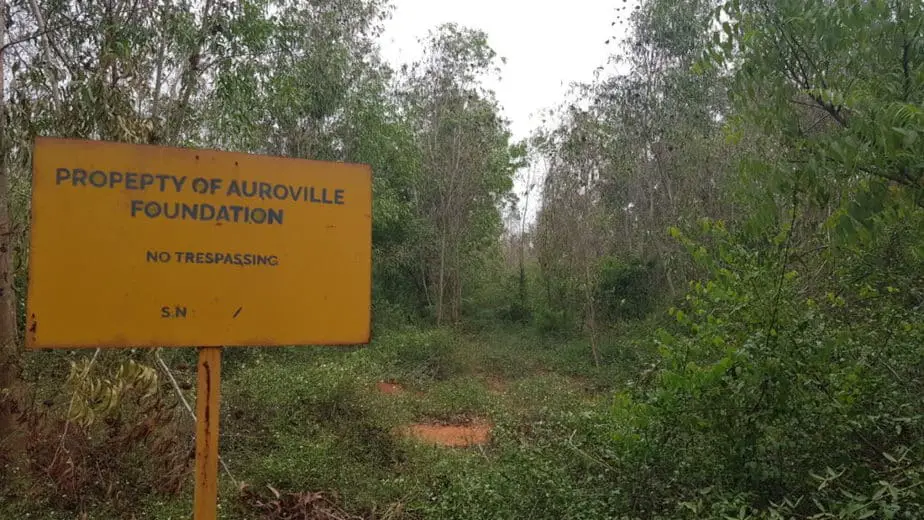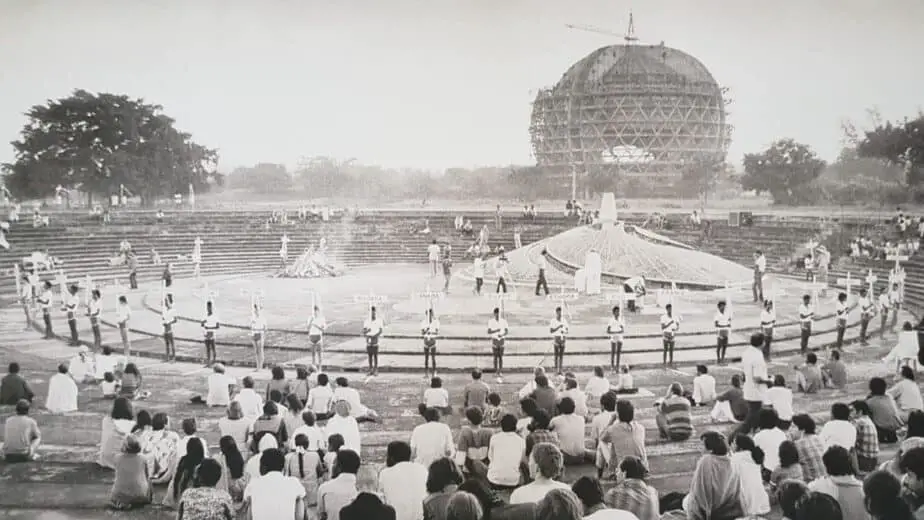I recently spent some time in Auroville and before I went I was doing a lot of research on it. It’s such a unique place!
What is special about Auroville? The residents reforested the desert turning the area into a jungle. They built a 29-meter tall gold-covered geodesic dome called the Matrimandir. They own the largest optically-perfect glass globe. They use solar oven to cook enough food for 1000 people a day.
As I stayed in the area, it was inspiring to learn about the special things the residents of Auroville were experimenting with. I may not be moving to Auroville anytime soon, but I can learn from their experiments as well as take their innovative approach to the community I live in.
Below I’ll share what I learned about what makes Auroville special from my trip and my research…
Building a Town from Scratch

It’s pretty special they built a town from nothing, with the approval of UNESCO and the Indian government. The Dalai Lama even came to visit twice!
They hired architects like Roger Anger, to design the overall plan of the city. Starting in 1966, it began in the shape of a Nebula, then moved into the shape of a Galaxy.
You can see some photos of the plans here.
The center is the heart, where the Matrimandir is, which is surrounded by the Crown (the circular paved road around it). Surrounding the center are four zones:
- Cultural
- Industrial
- International
- Residential
Twelve roads head out away from the center into the zones and then into the outskirts of the town. The outskirts of the city are the vast Green Belt with farms and forests.
It’s still a work in progress though. The original plan aimed to have 50,000 residents in 200 square kilometers.
Currently, Auroville has ~3000 residents and owns 84 square kilometers.
Turning a Barren Desert into a Lush Jungle

When Auroville was founded in the 1960s, over forestation had turned the area into a desert.
As the Matrimandir was being built, you could stand on the first-floor platform and see the ocean which is about 3 miles away. If you’ve been there recently, you wouldn’t believe that was possible. The place is a thick jungle!
I rode my scooter around for an hour on the dirt roads, and it was one of the first times in India that I felt so far away from people. It’s one of the most beautiful things about Auroville… the wide expanses of natural forested areas.
I was curious how they turned a desert into a jungle, so I did some research.
Auroville is 50 meters higher in elevation than the sea, so when the monsoons came the waters were taking away all the nutrients from the soil. Instead of rich black earth, it was red and nutrient-less.
They needed to keep the water on the soil, so they started building dikes and dams everywhere. Eventually, there were raised mounds of earth keeping water in like rice fields.
As the soil was able to retain water, then they were able to plant and grow local vegetation. As the vegetation died, more local varieties grew, and the soil became richer with bio-mass.
It sounds like there were still many challenges, for instance as they were trying to keep the aquifers full of water, and sometimes there was too much water!
But over the last 50 years, it’s hard to believe the place you see in the old photos is the same place. It’s also inspiring if you’re like me and might want to buy some land one day 🤓
Building the Matrimandir

It took approximately 20 years to build the Taj Mahal. It took between 10 to 20 years to build the Great Pyramids of Giza. But it took 37 years to build the Matrimandir! (Admittedly the Aurovillians had fewer slaves 🙂
The Mother called it the “Soul of Auroville” a place for trying to find one’s consciousness, and “the cohesive force of Auroville.”
It looks a little like the Epcot Center at Disneyland, except it’s covered in gold. There are 1415 gold-covered steel discs covering the dome. There are 28 grams of gold in 1000 gold leaves. Each leaf is 85 by 85 mm.
The foundation stone was laid in 1971. The chamber floor walls and roof were finished in 1979.
Roger Anger designed it with 12 “petals” or meditation rooms that symbolize consciousness with names like Bliss and Concentration.
Inside the dome, is white paint and white Merino wool carpets woven in Agra. The innermost room has 12 stately pillars, with white cushions on the floor, and it looks like something out of a sci-film or the Alejandro Jodorowsky film, Holy Mountain.
To see inside the dome, you have to register and usually will wait between 1 and 3 days to visit. You can register for free. If you are with a resident of Auroville, you can visit the dome without waiting.
To view the dome from about 1 kilometer away, you can get a free pass at the Visitors Centre and view it at any time. It’s about a 10 to 12-minute walk from the Centre or you can take a bus.
Interesting Fact: During construction of the Matrimandir, four supportive pillars were taken down on November 17, 1973 at 7:25 pm, so that the dome stood on its own for the first time. This is the same time that The Mother passed away.
Buying a Perfect Glass Globe

In the center of the Matrimandir is the largest optically perfect glass globe in the world.
It’s a 400-kilogram crystal sphere made from glass called Bohr Kron 7. They cast it on May 12, 1987 in Germany for the first time. It had to be cast again a couple of months later.
It is estimated to have cost 230,000 German Marks (~$498,000 USD).
Cooking with Solar Power
Solar ovens are pretty popular on Youtube in off-grid living videos. You can buy an “Amazon’s Choice” portable solar oven for cooking while camping. But Auroville took solar oven cooking to the next level!
Using 11,000 bathroom mirrors they built a solar concentrator that uses steam power to cooking. Today the “Solar Bowl” can cook over 1000 meals a day.
Auroville has also been involved in solar programs across India. They’ve installed 8700 solar lighting kits in regions of Kashmir and Jammu. In 1994, they installed 555 solar water pumps in Punjab and 1025 pumps across India.
In 1997, they built the Matrimandir Solar Power Plant, which at the time was the largest system in India. It had 484 photovoltaic cells and a capacity greater than 36 kilowatts, so it could light over 700 homes and offices.
Building with the Earth

I eventually want to build a home out of earth on my own land, so I was curious about how Aurovillians have been experimenting with architecture.
Using a press to make Compressed Earth Blocks, they have built sturdy bricks and made them into many cost-effective buildings.
If you are interested you can see the details here.
Locally Sourced Seeds, Supplements and Coffee

I live a few hours from Auroville and I buy a lot of the products they produce there.
They have raw sprouted sunflower seeds, pumpkin seeds, flax seeds, and more. I like their spirulina. Basically, if you’re looking for healthy hippie products in South India, Auroville is a strong branch.
I mentioned coffee, although I’m cheating a bit with this one. Marc’s Coffee is a cafe and roaster that’s technically outside the township, but still probably considered a part of Auroville.
Marc’s Coffee is organic, fair trade, bio-dynamic and locally sourced in India in small batches. You can go to the cafe and get the espresso, cappuccinos, Americanos, and of course, South Indian style coffee. As a coffee lover it was one of the highlights of my trip, which is why I felt obligated to include it 🙂
Related Questions:
What is Auroville?
It’s a town of about 3000 people, who pride themselves on experimenting with sustainable farming, architecture, energy and food production. It sits on 84 square kilometers near Pondicherry and is worth visiting if you are traveling in South India.
Auroville Documentary?
You can watch Auroville EcoVillage Documentary, City of the Dawn on Youtube. I liked Auroville: From Utopia to Reality for a bit more production and entertainment values.
How Safe is Auroville?
It’s as safe as any rural area in India. Be careful at night and don’t be too flashy with your wealth. Dress modestly and be respectful of the local cultures. Wear sunscreen and good footwear… keep an eye out for snakes and scorpions.
What Should You Wear in Auroville?
Wear clothes that cover your knees and shoulders. It should be considered conservative. If you wear Indian-style clothes, you will better fit in. Auroville is mostly made up of local Indian villages, so it’s the same as anywhere in India. I wore t-shirts and shorts and fit in though.


